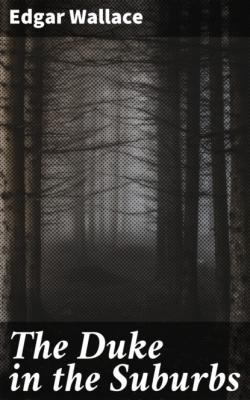The Duke in the Suburbs. Edgar Wallace
Читать онлайн.| Название | The Duke in the Suburbs |
|---|---|
| Автор произведения | Edgar Wallace |
| Жанр | Языкознание |
| Серия | |
| Издательство | Языкознание |
| Год выпуска | 0 |
| isbn | 4064066095567 |
Edgar Wallace
The Duke in the Suburbs
Published by Good Press, 2021
EAN 4064066095567
Table of Contents
"
Dedication
TO
MARION CALDECOTT
WITH THE AUTHOR'S
HOMAGE
Author's Apology
The author, who is merely an inventor of stories, may at little cost impress his readers with the scope of his general knowledge. For he may place the scene of his story in Milan at the Court of the Visconti and throw back the action half a thousand years, drawing across his stage splendid figures slimly silked or sombrely satined, and fill their mouths with such awsome oaths as "By Bacchus!" or "Sapristi!" and the like. He may also, does the fine fancy seize him, take for his villain no less a personage than Monseigneur, for hero a Florentine Count, as bright lady of the piece, a swooning flower of the Renaissance, all pink and white, with a bodice of plum velvet cut square at the breast, and showing the milk-white purity of her strong young throat.
It is indeed a more difficult matter when one is less of an inventor, than a painstaking recorder of facts.
When our characters are conventionally attired in trousers of the latest fashion, and ransacking mythology the oath-makers can accept no god worthier of witness than High Jove.
Greatest of all disabilities consider this fact: that the scene must be laid in Brockley, S.E., a respectable suburb of London, and you realize the apparent hopelessness of the self-imposed task of the writer who would weave romance from such unpromising material.
It would indeed seem well-nigh hopeless to extract the exact proportions of tragedy and farce from Kymott Crescent that go to make your true comedy, were it not for the intervention of the Duke, of Hank, his friend, of Mr. Roderick Nape, of Big Bill Slewer of Four Ways, Texas, and last, but by no means least, Miss Alicia Terrill of "The Ferns," 66, Kymott Crescent.
Part I
THE DUKE ARRIVES
I
The local directory is a useful institution to the stranger, but the intimate directory of suburbia, the libellous "Who's Who," has never and will never be printed. Set in parallel columns, it must be clear to the meanest intelligence that, given a free hand, the directory editor could produce a volume which for sparkle and interest, would surpass the finest work that author has produced, or free library put into circulation. Thus:—
AUTHORIZED STATEMENT. PRIVATE AMENDMENT.
KYMOTT CRESCENT.
44. Mr. A. B. Wilkes. Wilkes drinks: comes home
Merchant. in cabs which he can ill
afford. Young George
Wilkes is a most insufferable
little beast, uses scent
in large quantities. Mrs.
W. has not had a new dress
for years.
56. Mr. T. B. Coyter. Coyter has three stories which
Accountant. he *will* insist upon repeating.
Mrs. C. smokes and is
considered a little fast.
No children: two cats,
which Mrs. C. calls "her
darlings." C. lost a lot of
money in a ginger beer
enterprise.
66. Mrs. Terrill. Very close, not sociable, in
fact, "stuck up." Daughter
rather pretty, but
stand-offish—believed to have
lived in great style before
Mr. T. died, but now
scraping along on £200 a
year. Never give parties
and seldom go out.
74. Mr. Nape Retired civil servant. Son
Roderick supposed to be
very clever; never cuts his
hair: a great brooder,
reads too many trashy
detective stories.
And so on ad infinitum, or rather until the portentous and grave pronouncement "Here is Kymott Terrace" shuts off the Crescent, its constitution and history. There are hundreds of Kymott Crescents in London Suburbia, populated by immaculate youths of a certain set and rigid pattern, of girls who affect open-worked blouses and short sleeves, of deliberate old gentlemen who water their gardens and set crude traps for the devastating caterpillar. And the young men play cricket in snowy flannels, and the girls get hot and messy at tennis, and the old gentlemen foregather in the evening at the nearest open space to play bowls with some labour and no little dignity. So it was with the Crescent.
In this pretty thoroughfare with its £100 p.a. houses (detached), its tiny carriage drives, its white muslin curtains hanging stiffly from glittering brass bands, its window boxes of clustering geraniums and its neat lawns, it was a tradition that no one house knew anything about its next-door neighbour—or wanted to know. You might imagine, did you find yourself deficient in charity, that such a praiseworthy attitude was in the nature of a polite fiction, but you may judge for yourself.
The news that No. 64, for so long standing empty, and bearing on its blank windows the legend "To Let—apply caretaker," had at length found a tenant was general property on September 6. The information that the new people would move in on the 17th was not so widespread until two days before that date.
Master Willie Outram (of 65, "Fairlawn ") announced his intention of "seeing what they'd got," and was very promptly and properly reproved by his mother.
"You will be good enough to remember that only rude people stare at other people's furniture when it is being carried into the house," she admonished icily; "be good enough to keep away, and if I see you near 64 when the van comes I shall be very cross."
Which gives the lie to the detractors of Kymott Crescent.
Her
